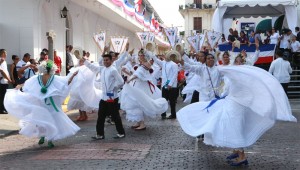Panama is a very proud country, and like any country, loves to celebrate its independence, and recognize its history. But Panama, in a way, is unique in how they celebrate. Most of their national holidays are in the month of November. Paired with Christmas in December, and the dry Summer season’s start, November really is the kick-off of the holiday season, and a fun time to mix and mingle with the locals. There are five official national holidays in the month of November, but it feels like more, as many are near the weekend, or lead to people adding them to their yearly vacation time. Here’s more on what they’re celebrating, and how they celebrate.
What Do the Holidays Mean?

Nov. 3rd: Independence From Colombia Day, or “Separacion de Colombia.” Many expats may not know, but Panama was once a part of Colombia, before the US helped leverage military support (1903), as part of the original dealings to obtain rights for the Canal.
Nov. 4th: Flag Day, or “Dia de la Bandera.” This day is more of a general showing of military pride, and national pride. It’s not as big of a celebration as some of the others, but is still filled with fanfare, music, and parades.
Nov. 5th: Colon Day, or “Dia de Colon.” This day celebrates the liberation of the city and port of Colon, on the north shore of Panama’s Caribbean coast. Despite declaring independence from Colombia just a few days earlier, one Colombian battalion holed up in Colon. This day celebrates the final battle, and official end to the Colombian-controlled era.
Nov. 10th: The First Cry for Independence, or “El Primer Grito de Indepencia.” This commemorates the beginning of the independence battle with Spain. The movement began west of the capital in Los Santos, and would be the catalyst for the entire country’s independence shortly after.
Nov. 28th: Independence from Spain Day, or “Independencia de Espana.” After the uprising in Los Santos, the movement spread quickly throughout the country, eventually hitting the capital. With most of the colonial military turning on Spain, and a short battle, the Spaniards left, beginning Panama’s 1st period of post-colonialism and independence.
How do Panamanians Celebrate November Holidays
Because of their patriotic nature, and historical significance, each holiday has a variety of parades, speeches, and cultural events to show off Panama’s local colors. Traditional food and costume is typical in most celebrations, and in all parts of the country, marching bands compete for supremacy, showing off a year’s worth of practice with local music and rhythms. It’s a very laid back scene at the parades, and people like to march and dance with the bands or alongside them throughout the day.
Aside from parades and official celebrations, the “Fiestas Patrias” are a big domestic tourism period. The city tends to empty out, and beach towns, and interior destinations tend to get rather crowded. Think of it like 4th of July weekend, but repeated 3-4 times in one month. If you plan on traveling to the beaches, or other tourist locations within the country, make sure to book early, and expect lots of crowds, and lots of traffic. Non-tourist businesses around the country essentially come to a complete halt, and schools are all closed.
All-in-all, it’s a great time to visit Panama, whether you’re coming from abroad, or already live here. It’s the happiest time, in one of the happiest countries, and a great expression of national pride and history.